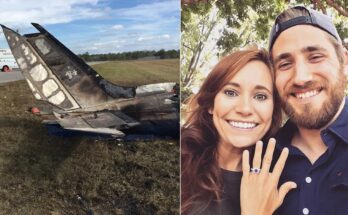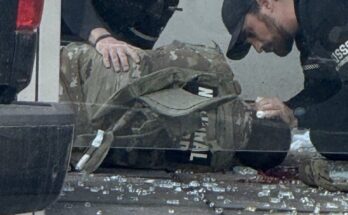
An Air Force rookie pilot crashed a $140million F-22 stealth fighter jet on the runway right after takeoff because they took off too slowly and pulled the nose up too early, an investigation has revealed.
The student, using the callsign ‘Topgun 65’, was preparing for a training flight to perform BFM (Basic Fighter Maneuvers) against an F-18 Hornet when the aircraft ended up crashed at the Naval Air Station Fallon, Nevada, on April 13, 2018
The Aircraft Accident Investigation Board concluded that the pilot crashed the plane because the pilot brought the nose up to early, failed to reach the right speed for take off and prematurely retracted the landing gear.
The F-22 took off going 23 knots below the recommended speed, which was fast enough to leave the ground but too slow to keep the plane in the air.
The crash prompted a retraining of all pilots using the aircraft to prevent more blunders in the future.

After the pilot brought the landing gear up, seconds after leaving the runway, the plane began to sink back down.
The pilot safely got out of the aircraft and there were no other injuries. The cost and the extent of the damage has not been revealed.
However, because proper takeoff speed had not been reached the plane could not maintain its airborne trajectory and returned to the runway with its landing gear retracted.
The report found that early rotation was not only common to the pilot involved in the crash, but also to multiple TOPGUN students.
The attempted flight was a TOPGUN graduation exercise, with the mission of flying ‘to a predetermined point in the assigned airspace in order to fight Basic Fighter Maneuvers (BFM) against a Navy F-18 Hornet.’
Since the incident occurred, a review of proper takeoff and landing procedures was completed for all pilots to identify and eliminate any commonplace improper techniques that may be lingering, Business Insider reported.

The F-22A Raptor stealth tactical fighter aircraft crash landed during takeoff at NAS Fallon in Nevada, at 10.45am Pacific Daylight Savings time on April 13.
The aircraft then slid 6514 feet on its underside before coming to rest 9,419 feet from the runway threshold, after which the pilot safely emerged from the plane.
‘There were no injuries, fatalities, or damage to civilian property,’ the report, signed by USAF Colonel Jacob Trigler, who is the president of Accident Investigation Board, read.
‘The MP [mishap pilot] failed to ensure that he was operating the aircraft IAW [in accordance with] valid TOLD [takeoff and landing data] and then prematurely retracted the LG [landing gear],’ the report read.
‘If the MP had performed his takeoff sequence IAW the correct TOLD or if he delayed his LG retraction until the MA [mishap aircraft] had accelerated to the correct takeoff speed, this mishap would not have occurred.’
The report acknowledged that although specific procedural errors made by the pilot are what caused the crash, the reason the pilot took those actions was at least partially due to improper training the pilot received

‘[T]he organization factors contributing to this mishap were significant in influencing and shaping the MP’s actions,’ the report read.
‘The technique of rotating early will not by itself cause this type of accident. However, rotating early starts a sequence of events that can lead to an early takeoff and early gear retraction. This situation is magnified when an aircraft is operating at a high elevation airfield where aircraft performance is decreased.
The report cited ‘inadequate flight brief, organizational acceptance of an incorrect technique, formal training, and organizational overconfidence in equipment’ substantially contributed to the mishap.
Analysis showed that not only the pilot of this crashed plane, but also multiple TOPGUN pilots, displayed a habit of rotating at similar speeds, which was determined to be early in this case, given the conditions at NAS Fallon.
‘There is a clear trend of rotating early among a significant number of F-22 pilots, including the MP, despite being aware of computed TOLD,’ the report read.
‘The AIB discovered that 80.4% of all pilots sampled became airborne greater than 5 knots before achieving their takeoff speed


